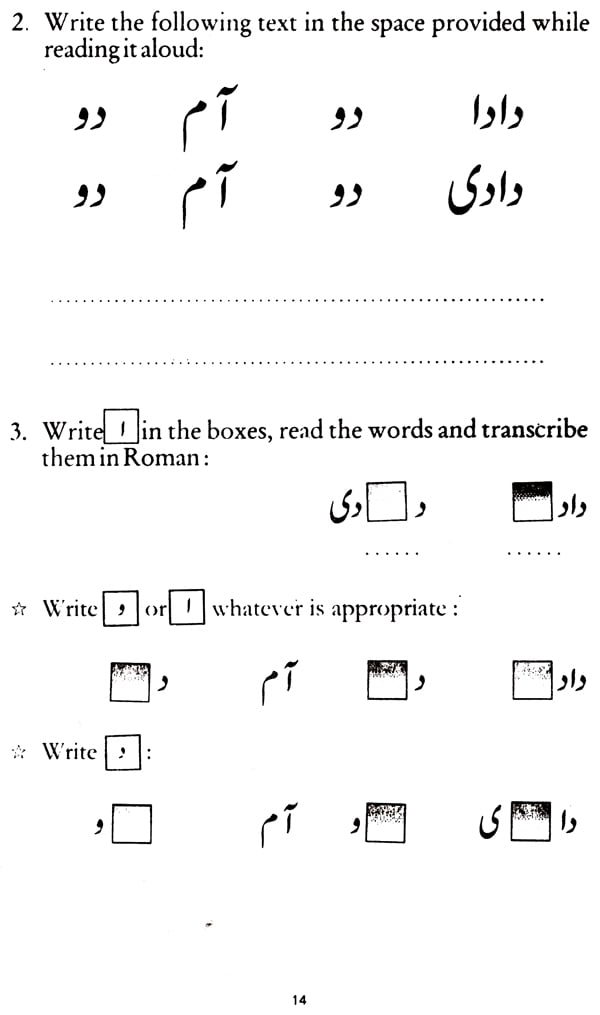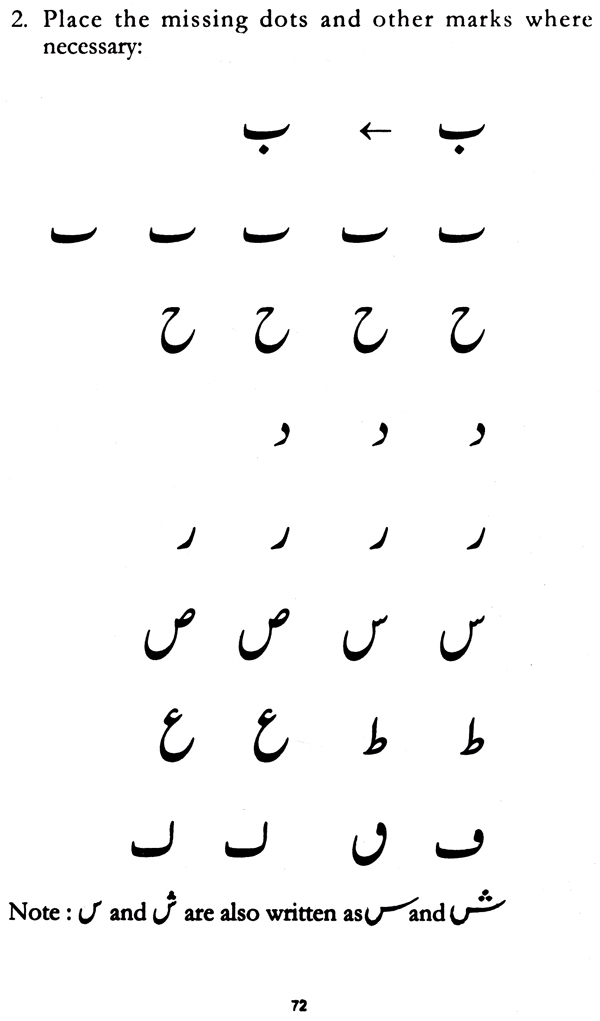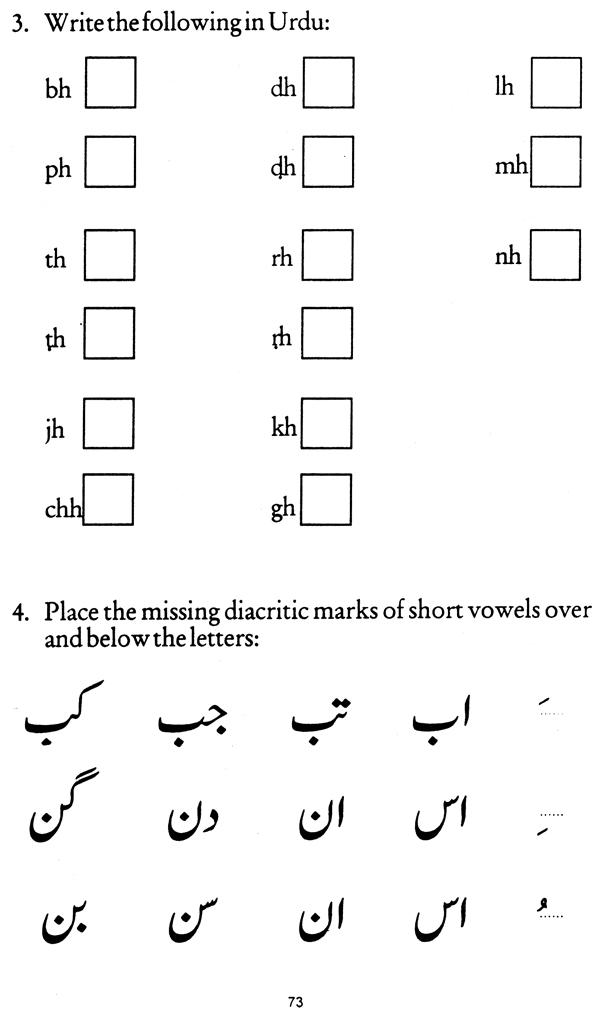
Work Book: Lets Learn Urdu (Beginers Manual for Urdu Script)
Book Specification
| Item Code: | NAS494 |
| Author: | Gopi Chand Narang |
| Publisher: | National Council for Promotion of Urdu Language |
| Language: | English and Urdu |
| Edition: | 2019 |
| Pages: | 80 |
| Cover: | PAPERBACK |
| Other Details | 8.50 X 5.50 inch |
| Weight | 110 gm |
Book Description
This beginner's Manual for Urdu Script is meant for those who are conversant with spoken Urdu or Hindi, and want to learn Urdu script in the shortest possible time. It is written in the Distance Education mode and everything is self-explanatory. The concepts are introduced gradually, and the characters, words and sentences have been repeated sufficiently so that they are well engrained in the mind of the learner. The Manual is accompanied by a Work Book where things are further explained. The learner must proceed lesson by lesson, and must complete the related exercises in the Work Book. The Work Book contains sufficient reading and writing exercises, which, if followed properly, will render the learning of Urdu script easy and enjoyable.
The Urdu script has been introduced in a graded and scientific manner. The learner who wants to learn Urdu alphabet in the traditional order is welcome to do so. A complete chart of the Urdu alphabet in the traditional order is also provided. However, the lessons introduce the Urdu alphabet gradually and systematically. The Urdu letters are of two types, connectors and non-connectors. The lessons first introduce the non-connectors which are easy to learn. Similarly, combinations which are simple and easy, are introduced in the beginning. The connectors and concepts which are comparatively difficult have been taken up later. The learner, if he moves step by step according to the order of lessons, and follows instructions while completing the reading and writing exercises in the Work Book, will not feel any difficulty. Care has been taken to teach the Urdu alphabet through names of objects which are illustrated to make the learning less cumbersome and pleasant.
A short introduction to Urdu script is provided in the beginning. The learner is advised to go through it before beginning the book. Of course, the concepts will become fully clear only after the learner has completed all the lessons and all the exercises. The script, in fact, is introduced in the first 12 lessons. Thus, those learners who may master one lesson each week can learn the Urdu script in a period of three months. However, motivation and learning ability plays a major role in the learning process. The learner is advised to practise writing as much as possible, as nothing reinforces reading more than the writing.
In the Manual new characters and combinations are shown in red boxes. They are drilled enough so that by the end of each lesson the learner can easily recognise and read the new elements. At the end of the lessons a complete chart of the new characters and combinations is again given in red boxes for reinforcement.
The names of the Urdu letters are given at the top of the box while the transcription of the sound is given below. Urdu is rich in duplicators and triplicators, i.e., where some letters stand for one sound. A compelete chart of Urdu alphabet denoting the sounds is also given for reference. Complete tables of vowel system and diacritics, traditional order of sequences, as well as the table of different shapes of Urdu letters and their combinations are also provided. All this will be of use and will help the process of systematic learning.
The Work Book uses turquoise boxes for exercises and for filling the responses. To facilitate the learning process of writing Urdu characters, the direction and movement of hand is indicated by small arrows. New words and sentences are also given in the dotted (broken) format so that the learner may write over them in pencil, practising sufficiently to perfect his writing.
The Urdu text has been adopted from the Urdu Ki Nai Kitab- I prepared by me and published by the National Council for Educational Research and Training, New Delhi, which is widely used in many school systems in India. I wish to give my thanks. to the Director, NCPUL, Dr. M. Hamidullah Bhat, and to my fellow Committee Members, without whose co-operation and help the present project would, not have been completed in time.
The National Council for Promotion of Urdu Language (NCPUL), an autonomous organization under the Ministry of Human Resource Development, Department of Secondary and Higher Education, Government of India, has been set up to promote, develop and propagate Urdu language. The Council is also responsible for taking appropriate action for making available in Urdu language, the knowledge of scientific and technological development as well as knowledge of ideas, evolved in the modern context. To meet the above objectives the Council has decided to launch a Certificate Course for learning Urdu through the distance mode. The learning material has been specially prepared by a team of experts drawn from different Universities and Institutions as well as the inhouse experts. The material was discussed and scrutinised by the committee members under the supervision of Prof. Gopi Chand Narang. It is hoped that teaching through distance mode will meet the wide spread demand for the learning of Urdu.
I must express my profound thariks to Prof. Gopi Chand Narang and all the members of the committee for preparing the text books. I also express my appreciation for Dr. M.J. Warsi, who played an important role in coordinating the Urdu Correspondence Course Scheme.
I hope that the book will be of use to the students who wish to learn one of the most beautiful Indian scripts Urdu.
**Contents and Sample Pages**










